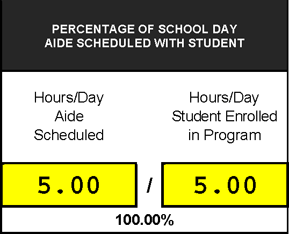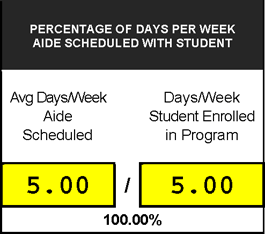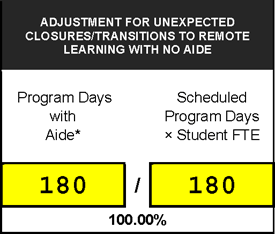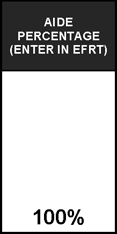Utilizing the Aide Percentage Box in EFRT for Student-Specific Education Aides
STAC ONLINE SYSTEM (EFRT) INTRODUCTORY TOPICSA User Guide for School Districts and Counties
Overview
To assist in calculating state reimbursement, the Aide Percentage box in the STAC Online (EFRT) System is used to document the percentage of time an education aide spends with a specific student during the enrollment period of the service approval. The Aide Percentage should be calculated based on the student’s IEP when the STAC record is entered prospectively (approval record), and revised, if necessary, once the school year concludes. (verification record)
This box should only be utilized by school districts and counties when the cost of the education aide/assistant is not included in a tuition rate.
Pursuant to direction from the New York State Division of the Budget, for the 2019-20 and 2020-21 school years, state reimbursement will only be provided for 1:1 aides for days on which the aides actually provide(d) either in-person or remote services consistent with the student's IEP. State reimbursement will not be provided for days that 1:1 aides were laid off, furloughed, or did not provide support services to students consistent with IEP requirements.
Previously, state reimbursement for a partial (other than 50%) or shared education aide (an aide that works with 2 or more students simultaneously) required the submission of a form to the STAC/Medicaid unit. With the implementation of the Aide Percentage box, the submission of paper forms is no longer required for partial and shared education aides.
Paper forms continue to be required for student-specific nurses, student-specific interpreters, maintenance aides, and out-of-state education aides. For the 2019/20 school year, and/or if there is a school closure in 2020/21, please submit 2 paper forms (covering the time periods before the closure and after the closure):
- Preschool Student-Specific Nurses and Interpreters

- School Age Student-Specific Aides, Nurses, and Interpreters

Separate forms must be submitted for the July/August ESY enrollment and the September-June 10-month enrollment.
Placement Types
The Aide Percentage box is found on the following EFRT online screens/placement types:
Preschool Placement Type:
- DSPRE (2-month and 10-month)
School Age Placement Types:
- DSUMR (2-month public/private)
- DSPRV (10-month private)
- DSCSM (2-month Chapter)
- DSCHP (10-month Chapter)
Formula for Calculating the Student-Specific Aide Percentage
Note: For the 2019/2020 and 2020/2021 school years, the Aide Percentage must account for student-specific aide services not delivered due to school closures from the COVID-19 pandemic (see box 3 of the formula). Pursuant to direction from the Division of the Budget, for the 2019-20 and 2020-21 school years, state reimbursement will only be provided for 1:1 aides for days on which the aides provide(d) in-person or remote services consistent with the student's IEP.
For each student with an add-on student-specific aide prescribed on his/her IEP, school districts and counties should use the Aide Percentage Calculation Worksheet (click on link or refer to the STAC website) for determining the Aide Percentage to be entered in EFRT.
Note: The worksheet is a tool for assisting school districts and counties in calculating the Aide Percentage for each student. The form is not to be submitted to the STAC/Medicaid unit.
The worksheet should be used for each student record; separate calculations are required for 2 and 10-month periods. The worksheet uses three parameters to calculate the Aide Percentage. The instructions for using the worksheet are outlined below:
Student-Specific Education Aides
This section should be used for all student-specific education aides, including shared aides. The aide percentage calculated in this section assumes the services were provided on a one-to-one basis. If an aide worked with 2 or more students simultaneously, also complete the Shared Education Aides section.
Percentage of School Day Aide Scheduled with Student

This part of the Aide Percentage formula calculates the percentage of time each day the student-specific education aide is scheduled to spend with the student.
- Hours/Day Aide Scheduled – enter the number of hours each day the aide is scheduled to spend with the student, per the student’s IEP.
Example: The student’s IEP recommends that the student-specific education aide spend 2.5 hours each day with the student. District/county would enter “2.50” in this field. - Hours/Day Student Enrolled in Program – enter the number of hours each day the student is
enrolled in the program to receive educational services.
Example: The student’s IEP authorizes the student to receive 2.5 hours of education each day in a 5.0 hour per day program. District/county would enter “2.50” in this field.
Percentage of Days per Week Aide Scheduled with Student

This part of the Aide Percentage formula calculates the percentage of time per week that the student-specific education aide is scheduled to spend with the student.
- Avg. Days/Week Aide Scheduled – enter the average days per week the student-specific
education aide is scheduled to be with the student based on the CSE/CPSE
recommendation on the student’s IEP.
Example 1: Student’s IEP authorizes one-to-one aide services 5 days per week. The school schedules the one-to-one aide services in the classroom each Monday through Friday. District/county would enter “5” in this field.
Example 2: For the 2019/2020 school year, the student’s IEP authorizes one-to-one aide services 5 days per week. The school is offering both classroom and remote services. Due to the flexibility in providing services, the school schedules one-to-one aide services for a student in the classroom Monday/Wednesday/Friday for the first week (remote learning Tuesday/Thursday) and Tuesday/Thursday for the second week (remote learning Monday/Wednesday/Friday), alternating this pattern throughout the school year. There is no one-to-one aide scheduled when the student is participating remotely. In this example, the school district or county would sum the total number of days the aide was scheduled to be with the student, per the student’s IEP, and divide by the number of days enrolled in the program, and multiply the result by 5, rounded to the nearest hundredth of a percent. - Days/Week Student Enrolled in Program – enter the number of days each week the
student is enrolled in the program to receive education services.
Example: Student’s IEP authorizes education services 5 days per week. District/county would enter “5” in this field.
Adjustment for Unexpected Closures/Transitions to Remote Learning with No Aide

This part of the formula provides for an adjustment percentage in the event there is an unexpected school closure, or a student transitions to a different learning model during the school year (e.g., from in-person learning [with student-specific aide services] to remote learning [without student-specific aide services]). This part of the formula may or may not apply to a student.
IMPORTANT: If neither of these situations apply to the student, the district/county should enter “1” in each field in this section (calculated percentage in this section will be 100%).
- Program Days with Aide – enter the number of days the student is scheduled to have
student-specific aide services. Include days when the student is legally absent (e.g., illness).
Do not include days when the school is unexpectedly closed (e.g., Governor closes school
for a month due to COVID-19). If the student transitions to a remote learning model during
the year (e.g., student transitions from classroom learning model [with aide services] to
remote learning model [without aide services] in January), do not count the remote learning
days, since during those remote learning days, there was no aide service. If the student is
scheduled to receive aide services at home (aide is physically at the student’s home), or is
scheduled to receive virtual aide services (e.g., via Zoom) consistent with the student's IEP,
then include those days.
Example 1: Student’s IEP authorizes education services for 10 months. 1:1 aide services are authorized for 5 days per week (180 program days) during the school year. The student is scheduled to receive services in the classroom. The Governor closes schools January 1 – February 28 due to a COVID-19 outbreak in the state. During this closure, the school district would have had 32 program days. District/county would enter “148” in this field. (180 program days minus 32 program days).
Example 2: Student’s IEP authorizes education services for 10 months. 1:1 aide services are authorized for 5 days per week (180 program days) during the school year. The student is scheduled to receive services in the classroom. Beginning March, the student transitions from a classroom learning model (with 1:1 aide services) to a remote model (without 1:1 aide services). There are 70 program days from March 1 – June 30. District/county would enter “110” in this field. (180 program days minus 70 program days).
Note: In the above examples, program days are days when the students are scheduled to receive instruction. - Scheduled Program Days × Student FTE – enter the product of the number of program days
and the student’s full-time equivalent (FTE), as listed on the service approval in EFRT. Most
programs operate for 180 session days, as required by SED.
Example: Program operates for 180 program days. Student FTE = .500. District/county would enter “90” in this field. (180 program days × .500).
Aide Percentage

The worksheet will calculate the Aide Percentage by multiplying the above 3 parameters. The district/county should enter that figure in the Aide Percentage box on the appropriate student-specific STAC online screen as noted in the beginning of these instructions.
Shared Education Aides
This section should be used for student-specific education aides working with multiple students at the same time.
Note: If an education aide worked with multiple students during the enrollment period but worked with each student on a one-to-one basis (student A from 8:00am – 11:00am and student B from 2:00pm – 3:00pm), this section doesn’t need to be completed. Instead, enter the Aide Percentage from the first section in the Aide Percentage box on the service approval screen within EFRT.

If the education aide is working with multiple students simultaneously, enter the total number of students (including this student) in the middle box. Enter the prorated aide percentage in the Aide Percentage box on the appropriate student-specific STAC online screen as noted in the beginning of these instructions.
Important Things to Keep in Mind
- Aide percentages must be reported as integers. Round up to the nearest whole percentage
point as necessary.
Example: 45.45% should be entered at “46” on the service approval screen.) - If a student-specific aide is required for all 12 months, the Aide Percentage must be calculated separately for 10-month and 2-month.
- Do not include teacher aides, teaching assistants, and paraprofessionals shared by all the students in the classroom. The costs for those positions are included in the tuition (education) rate.
- Do not include student-specific aide transportation time. For preschool placements and July/August school age placements, aide costs during transportation should be included in the transportation cost.
- Although students may receive more than 5 hours of instruction per day, the Hours Per Day
values in the formula should not exceed 5.
Example: A student attends a program that operates 5.5 hours per day. The aide is with the student for two hours a day. The calculation should be calculated using 2/5 for the Hours Per Day, not 2/5.5.